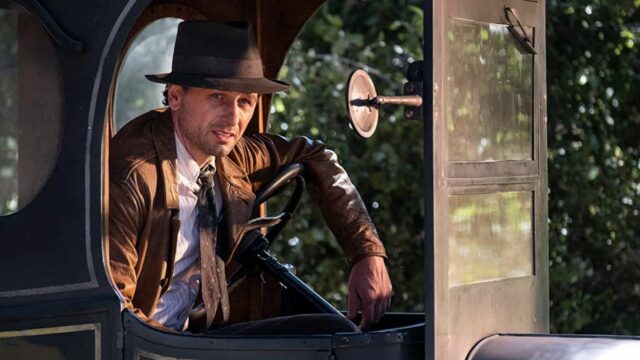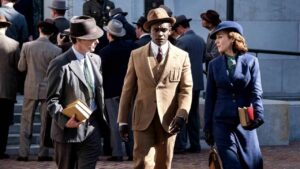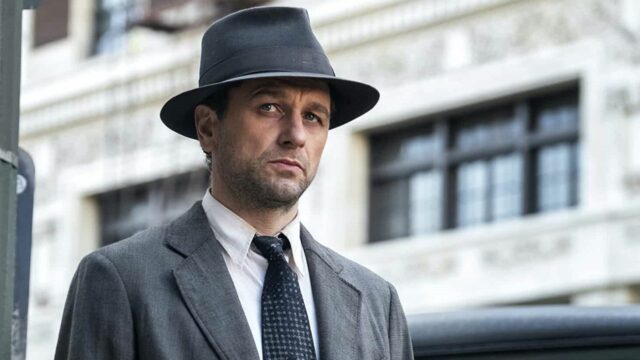Platinum blonde hair, deep red lips and a head to toe silver white gown – who can forget Sister Alice, the electric evangelist of HBO’s Perry Mason series.
But was she inspired by a real person?
Word is Sister Alice has been based on a real life priestess of a church body that still exists in the US. She too, like Sister Alice, was a travelling preacher who loved the radio and grand theatrics, and who too was a miracle healer.
Here are some incredible facts about Sister Aimee’s life which have direct parallels from the story arc of Perry Mason.
The miracles, her rebellion, and a kidnapping cum disappearance which all happened in Sister Aimee’s life and the HBO series, albeit tweaked.
Scroll on to find out more.
1. Real History Behind Sister Alice
Set in the Depression era, the HBO prequel to the hit courtroom drama Perry Mason gives one of the most raw accounts of the 1930 America.
Representing a tougher and harder America, the Depression era has always had some interesting and complex characters for writers to draw inspiration from.
One such character was that of Sister Aimee Semple McPherson, evangelist, faith-healer, founder of the Foursquare Gospel Church and one of the most famous women of her times.
Let history bear witness that Aimee Semple McPherson was an American phenomenon even before she went missing for five weeks in 1926.
Born Aimee Elizabeth Kennedy in 1890 to a religious Methodist Canadian family, Aimee began to rebel against her “tambourine-thumping Salvation Army” mother by reading novels and attending movies. (Also, this young rebel also went against the ideas of Charles Darwin’s Evolution, which had just broken out at the time. Recall another popular mystic hippie woman on American TV who refuted evolution? Could I be anymore obvious!)
By 1915, she had been married twice and walked out on her second husband, unable to bear living the life of a housewife, and become a travelling preacher.
She was accompanied by her two children, one from each marriage, and a Packard touring car that famously read,
“Jesus is coming soon – get ready”.
Despite leading a rather controversial and extremely public life, McPherson continued to build her church right up until her death in California, in 1944.
She is said to have overdosed on Seconol, which was found in the hotel room where she died.
At the time of her death, the Foursquare Gospel Church was worth millions, and claims nearly 9 million members worldwide even today.
But when Aimee Semple McPherson’s estate was sorted out, the evangelist had a modest $10,000 to her name.
2. Sister Aimee too was a Miracle Worker
Remember that particularly exasperating sequence from Perry Mason, involving a drowning boat and a savior Sister Alice where she eventually breaks down and has a vision that she will resurrect a dead baby?
Well, that’s not all imagination of the series writers. Sister Aimee was known for her very public displays of healing and miracle work.
She was more than just another female preacher and something of a Pentecostal novelty.
Sister Aimee learned to whip up crowds by speaking in tongues and delivering faith-healing demonstrations in which crutches were tossed aside and the blind were made to see.
The series even acknowledges this side to the evangelist. Soon after declaring that she will be performing a resurrection on Easter Sunday, Sister Aimee starts public healing sessions.
After one such session, when Sister Alice is confronted by a rival male preacher as to why a cripple cured by her stopped walking just a few days later, she replies,
“Because his faith was weak.”
The legitimacy of this sequence and the very real events it stood for remain contestable.
But fact is that within seven years of starting her journey, Sister Aimee was breaking attendance records set by the biggest evangelical names at the time, such as Billy Sunday, the former baseball star.
In San Diego, more than 30,000 people turned out for one of her events, and the Marines had to be called in for crowd control.
There, McPherson laid hands on a supposedly paralyzed woman who rose from her chair and walked. The audience reached a frenzy. (Probably the very scene portrayed in the show.)
Even after her infamous disappearance act in 1926, when she was accused of faking a kidnapping, McPherson came home to a 50,000 solid crow at the train station to welcome her.
In a massive parade featuring airplanes that dropped roses from the skies, the evangelist made a grand re-entrance. (Not even kidding!)
As in the show, Los Angeles was where the Sister raised funds to build the Angelus Temple whose 5,300-capacity she packed in services, seven days a week.
She was known for a light-hearted and at times whimsical style of orating and singing, but with a lot of power and passion.
3. The Controversial Kidnapping
Aimee McPherson is believed to have disappeared during a swim on May 18, 1926. A ransom note delivered to McPherson’s mother, Minnie Kennedy, demanded $50,000 for the safe return of her daughter.
Having established herself as a household name across America, Sister Aimee sent the entire nation in shock after news of her disappearance and a likely drowning spread.
For a full five week in the summer of 1926, no woman in America commanded more headlines than the vanished “Sister Aimee.”
But alongside prayers were the countless rumors too. Countless rumors started to peddle. She’d disappeared to have an abortion. Or plastic surgery. Or an affair.
Gaining the most traction was the last story that centered on the fact that Kenneth Ormiston, a married engineer at the Christian radio station KFSG (owned by McPherson’s church) disappeared just when McPherson did.
The two worked together on McPherson’s regular broadcasts.
However, the prayers were soon answered and after a month of mourning and unending rumor, McPherson turned up in a small Mexican town, just south of Arizona.
She claimed to have walked across the “burning sands” of the desert to flee kidnappers and then collapsed.
She would be mocked in the media for years, but the scandal could not diminish her popularity.
Even today her presence is remembered in personifications like the brilliant character of Sister Alice on Perry Mason.
A force to be reckoned with, what do y’all think?
Source: Smithsonian Magazine







No Comments on Was Sister Alice from Perry Mason a Real Person?